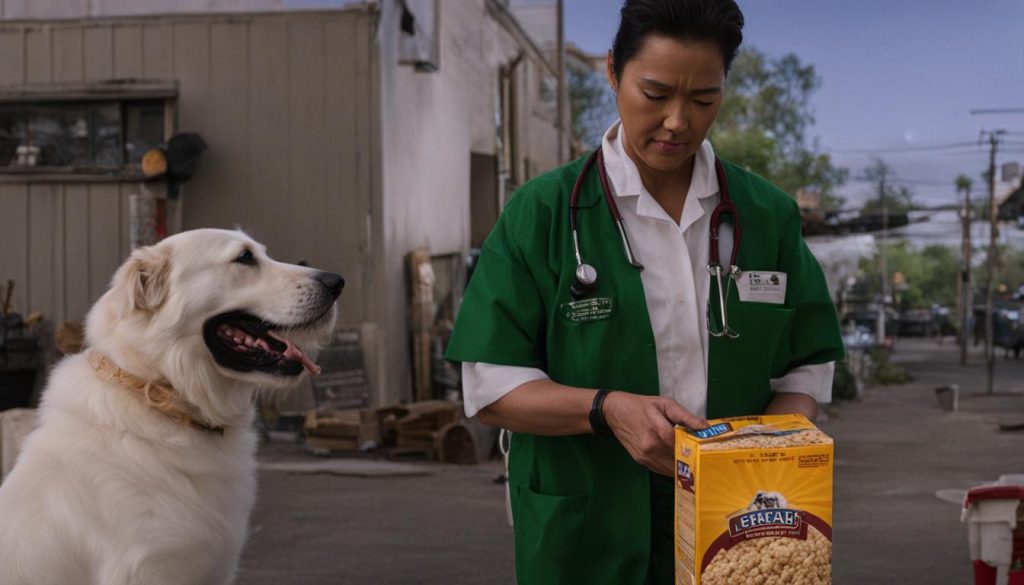Rice crispy treats are a beloved snack among humans, but what about our furry friends? Can dogs safely indulge in these crunchy delights? In this comprehensive guide, I will delve into the world of rice crispy treats for dogs, exploring their ingredients, nutritional value, and potential impact on canine health. We’ll also explore homemade alternatives and recipes for dog-friendly rice crispy treats.
Key Takeaways:
- Dogs can eat rice crispy treats in moderation, but caution is advised due to the high sugar content.
- Rice crispy treats made with store-bought Rice Krispies may contain additives that are not ideal for canine consumption.
- Homemade rice crispy treats can be a healthier alternative, using natural ingredients and low-sugar cereals.
- Consulting with a veterinarian is crucial to ensure the safety of rice crispy treats in a dog’s diet, especially for dogs with specific health conditions.
- Exploring healthier treat alternatives, such as fruits, vegetables, and lean meats, can provide dogs with nutritious and safe snacks.
Understanding Rice Krispies

Rice Krispies are oven-popped snacks made from rice that are commonly used to make rice crispy treats. They are primarily made from rice, sugar, salt, vitamins and minerals, corn syrup, barley malt flavoring, fructose, and vegetable oil. While rice is a safe and healthy ingredient for dogs, the presence of sugar and other additives in Rice Krispies makes them less ideal for canine consumption. It is important to understand the ingredients and manufacturing process of Rice Krispies before determining if they are safe for dogs.
To further investigate the safety of Rice Krispies for dogs, let’s take a closer look at the ingredients:
| Ingredient | Function | Concerns for Dogs |
|---|---|---|
| Rice | Main ingredient, provides carbohydrates | Safe for dogs |
| Sugar | Adds sweetness | High sugar content can be harmful to dental health and contribute to weight gain |
| Salt | Enhances flavor | Too much salt can lead to sodium toxicity in dogs |
| Vitamins and Minerals | Added for nutritional value | Generally safe, but excessive amounts can be harmful |
| Corn Syrup | Sweetener and binding agent | High in calories and can contribute to weight gain |
| Barley Malt Flavoring | Enhances taste | May be an irritant for dogs with gluten intolerance or allergies |
| Fructose | Sweetener | High fructose content can lead to weight gain and diabetes |
| Vegetable Oil | Adds texture and flavor | High fat content can contribute to weight gain and pancreatitis |
Based on the ingredients and their potential impact on a dog’s health, it is recommended to limit or avoid feeding Rice Krispies to dogs. While a small amount of Rice Krispies may not cause immediate harm, regular or excessive consumption can have negative consequences on a dog’s overall well-being. It is always best to opt for safer and healthier alternatives specifically designed for dogs.
Quote:
“While rice is a safe and healthy ingredient for dogs, the presence of sugar and other additives in Rice Krispies makes them less ideal for canine consumption.”
Understanding the ingredients and potential risks associated with Rice Krispies allows dog owners to make informed decisions when it comes to feeding their furry friends. By prioritizing their health and well-being, we can ensure that our dogs enjoy a balanced and nutritious diet.
Can Dogs Eat Rice Crispy Treats?

While dogs can eat rice crispy treats in moderation, there are some potential dangers and risks to consider. The high sugar content in these treats can be harmful to a dog’s teeth and contribute to weight gain and obesity. Additionally, some dogs may have allergies or sensitivities to certain ingredients, such as barley malt flavoring. It is important to feed rice crispy treats sparingly and monitor your dog for any adverse reactions or digestive issues.
Feeding rice crispy treats to dogs should always be done in moderation. It is crucial to maintain a balanced diet for your furry friend and avoid excessive consumption of these sugary treats. Instead, consider healthier alternatives like homemade treats or other dog-friendly snacks that are lower in sugar and contain natural ingredients. Consulting with a veterinarian can provide personalized advice based on your dog’s specific dietary needs and overall health.
Homemade Rice Crispy Treats for Dogs

When it comes to treating our furry friends, homemade options can be a healthier and safer choice. Making your own rice crispy treats for dogs allows you to have control over the ingredients and ensure that your dog is getting a tasty and nutritious snack. Here are a few dog-friendly rice crispy treat recipes that you can try:
- Peanut Butter Rice Crispy Treats: Mix rice cereal, peanut butter, and a natural sweetener like honey or mashed bananas. Press the mixture into a pan, let it cool, and cut into small squares.
- Pumpkin Spice Rice Crispy Treats: Combine rice cereal, pumpkin puree, a pinch of cinnamon, and a natural sweetener like maple syrup. Shape the mixture into balls or press into a pan and cut into shapes.
- Apple Cinnamon Rice Crispy Treats: Mix rice cereal, grated apple, a sprinkle of cinnamon, and a natural sweetener like unsweetened applesauce. Shape the mixture into balls or press into a pan and cut into squares.
These homemade recipes use ingredients that are safe and beneficial for dogs, providing them with a delicious treat that can be enjoyed in moderation. Remember to consult with your veterinarian to ensure that the ingredients are suitable for your dog’s specific dietary needs.
Benefits of Homemade Rice Crispy Treats
Choosing to make homemade rice crispy treats for your dog offers several advantages. Firstly, you have complete control over the ingredients, allowing you to avoid any potentially harmful additives or excess sugars. Secondly, homemade treats can be tailored to your dog’s preferences, incorporating flavors they enjoy or adding extra nutritional benefits. Finally, making your own treats can be a fun and rewarding activity for both you and your furry friend, strengthening the bond between you.
| Treat Recipe | Ingredients | Nutritional Benefits |
|---|---|---|
| Peanut Butter Rice Crispy Treats | Rice cereal, peanut butter, honey or mashed bananas | Protein from peanut butter, natural sweetness from honey or bananas |
| Pumpkin Spice Rice Crispy Treats | Rice cereal, pumpkin puree, cinnamon, maple syrup | Fiber and vitamins from pumpkin, natural sweetness from maple syrup |
| Apple Cinnamon Rice Crispy Treats | Rice cereal, grated apple, cinnamon, unsweetened applesauce | Vitamins and antioxidants from apple, natural sweetness from applesauce |
These recipes provide a starting point for creating homemade rice crispy treats for your dog. Feel free to modify them based on your dog’s preferences and any dietary restrictions they may have. Remember to always introduce new treats gradually and observe your dog for any adverse reactions.
Risks and Considerations
Feeding rice crispy treats to dogs can pose certain risks and considerations. While dogs can enjoy these treats in moderation, it is important to be aware of potential health issues that could arise from feeding them to dogs. The high sugar content in rice crispy treats can contribute to weight gain, dental problems, and even the development of diabetes in dogs. Additionally, some dogs may have specific dietary restrictions or allergies, making rice crispy treats unsuitable for them.
It is crucial to ensure the safety of rice crispy treats for dogs by practicing moderation and offering them as occasional rewards rather than regular meals or snacks. Consulting with a veterinarian before introducing rice crispy treats or any new food to a dog’s diet is highly recommended. Veterinarians can provide professional advice based on the specific dietary needs and health condition of the dog, ensuring that the treats do not have any adverse effects on their overall well-being.
To fully understand the potential risks, it is important to consider individual factors such as the dog’s age, breed, weight, and any existing health conditions. These factors can influence how rice crispy treats may affect a dog’s health. By seeking guidance from a veterinarian and making informed decisions, dog owners can ensure the safety of their pets while still being able to provide occasional treats.
| Risks of Feeding Rice Crispy Treats to Dogs | Potential Health Issues from Feeding Rice Crispy Treats to Dogs |
|---|---|
|
|
By being mindful of the risks and considerations associated with feeding rice crispy treats to dogs and taking necessary precautions, dog owners can ensure the well-being and safety of their furry companions.
Healthy Treat Alternatives

When it comes to treating our furry friends, there are plenty of healthy alternatives to rice crispy treats that can provide both nutrition and enjoyment. Instead of reaching for store-bought options that may contain high amounts of sugar and artificial additives, consider these dog-friendly treats made from natural ingredients. These alternatives not only satisfy their taste buds but also contribute to their overall well-being.
1. Fruits and Vegetables
Just like us, dogs can benefit from the vitamins and minerals found in fresh fruits and vegetables. Some safe options include sliced apples, baby carrots, blueberries, and green beans. These treats are low in calories and high in fiber, making them great alternatives for dogs who need to watch their weight. It’s important to remove any seeds, pits, or stems before offering these snacks to your canine companion.
2. Lean Meats
If your dog is a fan of meaty treats, opt for lean options like cooked chicken or turkey. These protein-packed snacks can be served in small portions, either as bite-sized pieces or mixed into their regular meals. Just be sure to remove any bones, skin, or seasonings that may be harmful to dogs. Lean meats provide essential amino acids that support muscle development and overall health.
3. Homemade Treats
For pet owners who prefer a hands-on approach, making homemade treats allows for complete control over the ingredients. There are numerous recipes available that use dog-friendly ingredients like peanut butter, pumpkin, or oats. By using natural sweeteners and low-sugar cereals, you can create delicious and nutritious treats that your dog will love. Homemade treats also provide an opportunity to cater to any specific dietary needs or allergies your dog may have.
| Treat | Ingredients | Benefits |
|---|---|---|
| Frozen Blueberries | Blueberries | Rich in antioxidants and vitamins |
| Fruit and Vegetable Popsicles | Pureed fruits and vegetables | Refreshing and nutritious |
| Air-Popped Popcorn | Plain, unsalted popcorn | Low in calories and high in fiber |
Remember to always introduce new treats gradually and in moderation. It’s also a good idea to consult with a veterinarian to ensure that the ingredients you choose are safe for your dog’s specific dietary needs. By opting for these healthy alternatives, you can provide your four-legged companion with tasty and nutritious snacks that promote their well-being.
Risks of Excessive Rice Crispy Treat Consumption

Feeding too many rice crispy treats to dogs can have several negative health consequences. The high sugar content in these treats can lead to weight gain and obesity, which can put strain on a dog’s joints and organs. Additionally, excessive consumption of rice crispy treats can contribute to dental problems, such as tooth decay and gum disease. Dogs that consume an excess of these treats may also be at a higher risk of developing diabetes.
It is crucial to remember that moderation is key when it comes to feeding rice crispy treats to dogs. While they can be an occasional tasty reward, they should not make up a significant portion of a dog’s diet. Instead, they should be offered sparingly and as part of a well-balanced, nutritious meal plan.
The Importance of Moderation
Practicing moderation in feeding rice crispy treats to dogs is essential to ensure their overall health and well-being. By limiting the amount of these treats given to dogs, pet owners can help prevent weight-related issues and maintain their dogs’ dental health. It is always advisable to consult with a veterinarian regarding the appropriate portion sizes and frequency of treat consumption based on a dog’s specific dietary needs and health conditions.
Choosing healthier alternatives and incorporating a variety of treats into a dog’s diet can provide both nutritional value and enjoyment. Homemade options made with natural ingredients and low-sugar alternatives can be a safer and more nutritious choice for dogs. Remember to always consider the individual needs of your dog and consult with a veterinarian for personalized advice.
Consultation with a Veterinarian

When it comes to feeding rice crispy treats to dogs, it is always wise to seek professional advice by consulting a veterinarian. They have the expertise and knowledge to assess the individual considerations for a dog’s dietary needs and provide personalized recommendations.
A veterinarian can evaluate the specific health condition of a dog and determine if rice crispy treats are suitable for their diet. Some dogs may have underlying health issues, such as gluten intolerance or diabetes, that make these treats less appropriate for them. By consulting with a veterinarian, pet owners can ensure that they are making informed decisions that prioritize their dog’s well-being.
Additionally, a veterinarian can offer guidance on suitable portion sizes and frequency of treats. Dogs have different dietary requirements based on their age, size, and activity level, and it is important to take these factors into account when incorporating rice crispy treats into their diet. A veterinarian can provide valuable insight into the moderation needed to maintain a balanced and healthy diet for dogs.
Expert Advice for Dog Owners
“Consulting a veterinarian is crucial when considering rice crispy treats for dogs. They can assess the dog’s specific dietary needs, evaluate any underlying health conditions, and offer professional advice on whether these treats are appropriate. Veterinarians can provide valuable insight into portion sizes and moderation, ensuring that dogs can enjoy treats while maintaining a healthy diet.” – Dr. Lisa Thompson, DVM
By seeking professional guidance through consultation with a veterinarian, dog owners can make informed decisions about feeding rice crispy treats to their furry friends. The individual considerations for a dog’s dietary needs can vary, and a veterinarian is the best resource to ensure the safety and well-being of dogs when introducing new treats into their diet.
Wrapping Up
To summarize, after careful analysis of the ingredients and nutritional value of rice crispy treats, it is clear that dogs can enjoy these snacks in moderation. However, pet owners must exercise caution due to the high sugar content and potential allergens present in store-bought rice crispy treats. Homemade alternatives, made with safe ingredients and low-sugar cereals, offer a healthier option for pampering our furry friends.
It is essential to consult with a veterinarian before introducing rice crispy treats or any new food to a dog’s diet. A veterinarian can provide personalized advice, considering the dog’s specific dietary needs and overall health. They can help determine suitable portion sizes and recommend alternative treats that are safe and beneficial.
Ultimately, the key to feeding rice crispy treats to dogs lies in responsible pet ownership. By understanding the risks and making informed choices, we can ensure that our dogs’ snacking habits contribute to their overall well-being.
FAQ
Can dogs safely eat Rice Krispies?
While dogs can eat rice crispy treats in moderation, it is important to be cautious due to the high sugar content and potential allergens present in Rice Krispies.
What are the risks of feeding rice crispy treats to dogs?
Feeding rice crispy treats to dogs can contribute to dental problems, weight gain, and nutritional imbalances if consumed in excess. Some dogs may also have allergies or intolerances to certain ingredients in these treats.
Are there healthier alternatives to rice crispy treats for dogs?
Yes, there are numerous healthier alternatives available, such as fruit, vegetables, lean meats, and low-sugar cereals. These options can provide essential nutrients and be a safer choice for dogs.
Should I consult with a veterinarian before feeding rice crispy treats to my dog?
Yes, it is always advisable to consult with a veterinarian before introducing any new food to your dog’s diet. They can provide personalized advice based on your dog’s specific dietary needs and health condition.
Can I make homemade rice crispy treats for my dog?
Yes, making homemade rice crispy treats for dogs can be a healthier alternative. By using dog-friendly ingredients and recipes, you can ensure that your dog is consuming safe and nutritious treats.
What are the potential health issues from excessive rice crispy treat consumption?
Excessive consumption of rice crispy treats can lead to weight gain, dental problems, and even the development of diabetes in dogs. It is important to practice moderation and offer treats as occasional rewards.
How can I ensure the safety of rice crispy treats for my dog?
Ensuring the safety of rice crispy treats for your dog involves feeding them in moderation, watching for any adverse reactions, and considering your dog’s specific health conditions and dietary needs.
What is the importance of consulting with a veterinarian?
Consulting with a veterinarian can provide professional advice tailored to your dog’s individual needs. They can guide you on suitable portion sizes, potential risks, and recommend alternative treats that are safe and beneficial.






